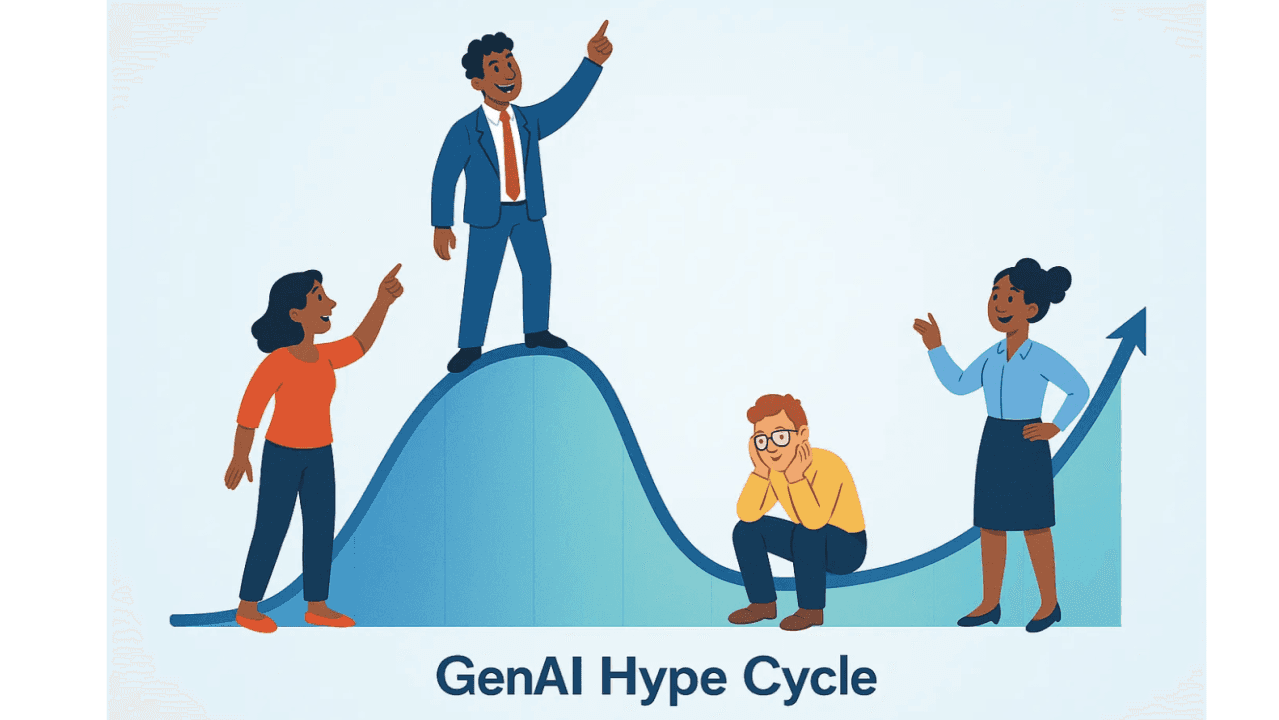
Where Are You on the GenAI Hype Cycle?
Prelude
GenAI feels like magic but behind every feature is a billion-dollar bet on unproven science. Sound familiar? That's because the economics of GenAI, surprisingly, mirror those of the pharmaceutical industry.
Today, I'll use pharma as a lens to understand GenAI economics. Pharma: An industry rooted in breakthrough innovation and complex economics of high-impact drug development.
Side note: The U.S. healthcare system is deeply flawed. Breakthroughs are real, but access to care should be far more equitable.
7 insights from pharma
[1] R&D costs: Developing a new drug, including failures, can cost around ~$1 billion. It's a high-stakes bet on unproven science, owned by leaders aiming to build a sustainable, life-changing pharma business.
[2] Smart bets: With limited billions, pharma leaders must balance customer need, impact, and likelihood of success. It's a delicate balance, play it too safe and you kill innovation; go too bold, draw attention, and miss delivering.
[3] Overheads: A lab breakthrough is just the start for a new drug. The real test is the lengthy, expensive trial, approval; often over 50% of total development time and costs. Insiders say excelling here is the real secret to pharma success.
[4] Low-utilization infrastructure: Pharma companies are required to maintain certified manufacturing facilities for producing small trial batches. These sites are expensive to operate, demanding strict compliance, ongoing validation, and trained personnel even with infrequent use. Often idle, yet critical.
[5] Profitability: Drugs are priced to recover R&D costs while fueling future innovation. A typical case of high gross but low net margins.
[6] Efficiency vs. Efficacy: Pharma leaders constantly trade-off - Does the drug work as intended in trials? Can it be developed, produced, and delivered quickly and cost-effectively? Efficacy demands rigor and time; efficiency pushes speed and cost often creating tension between the two.
[7] Distribution: Good pharma leaders build drugs that integrate into a patient's broader care journey; not stand alone "star" drugs that shine in isolation but fail in real impact due to missing ecosystem support. The true star is the patient, not the drug. Example: Aduhelm (an Alzheimer's Drug) showed scientific promise but failed to deliver real impact due to lack of ecosystem support and unclear patient benefit.
Back to GenAI
So what can GenAI PMs learn from all this? As it turns out, quite a lot.
Applying the 7 fundamentals to GenAI
So, taking all of this into account, if you're a GenAI Product Manager, here's how the lessons from pharma apply: GenAI PMs should take ownership of these critical areas to develop strong GenAI products and portfolios.
[1] R&D costs: As you prioritize features, remember, every GenAI product, feature is an expensive, unproven bet. Even if you don't own the budget, prioritize ruthlessly and advocate for smart allocation.
[2] Smart Bets: While user research and interviews are valuable, in GenAI, it's often more telling to watch what users actually do. For example, in GenVideo many users ask for longer video generation, yet use clips less than 3secs while focusing on frame-level edits, even when longer generations are available. If users knew longer videos meant less control over scene elements, many would reconsider. Users often assume quality and fidelity are a given until tradeoffs are made clear.
But we can't always surface every tradeoff. That's why PMs must read between the lines, recognizing the assumptions behind requests and make smart, responsible bets.
[3] Overheads: After successful research, it takes a village; time, people, money (GPUs), and yes, more research to make GenAI features real. The second wave of research is all about making it production-ready. The GenAI companies that win are the ones that nail scale and production, that's where real user value gets unlocked.
Google and Meta may appear to thrive on search algorithms or social networks, but beneath the surface, their true superpower lies in planet-scale infrastructure, serving billions reliably, with speed, and quality. Insiders know it's this robust backbone that acts like a mothership, effortlessly absorbing and scaling small products to a global audience.
[4] Low-utilization infrastructure: It's costly to serve GenAI models. Large models require massive GPU infrastructure, consuming the space and power of entire buildings, just to handle a few peak hours of daily traffic. Yet, this infrastructure must be maintained 24/7, driving up unit costs and hurting profitability. Like Retail, where PMs reduce footprint while boosting sales, or FedEx optimizing delivery via hub-and-spoke, GenAI PMs must push for efficiency; delivering high-quality results at scale, with lower cost.
[5] Profitability: With such high investment, GenAI PMs must own the profitability of every model and feature they endorse. For example, not all feature requests are equal, some impact foundational architecture (video resolution), while others are low-risk enhancements (video styles). Knowing the difference is key. Track costs, map a clear path to revenue, and develop an intuition for a model's life-cycle in market. Balancing bold bets with sustainable returns is tough in a fast-moving, FOMO-driven GenAI space, but it's essential for building lasting value.
[6] Efficiency vs. Efficacy: How fast, cheap, and scalable is the inference or training? vs. Does the model generate relevant, high-quality outputs? A constant trade off PMs should own.
[7] Distribution: Build features that truly fit into the user's workflow. For example, A flashy auto-spin camera pan might generate social buzz, but rarely serves real creators working on commercial video workflows. What they often need are un-glamorous tools like extending a clip by 2 seconds.
Closing thoughts
Being a GenAI PM isn't about chasing buzzwords or the next hot feature. It's about bringing clarity, making smart bets, and owning outcomes like it's your own capital on the line. Don't be a PM who just ships models, be one that prescribes the future responsibly.